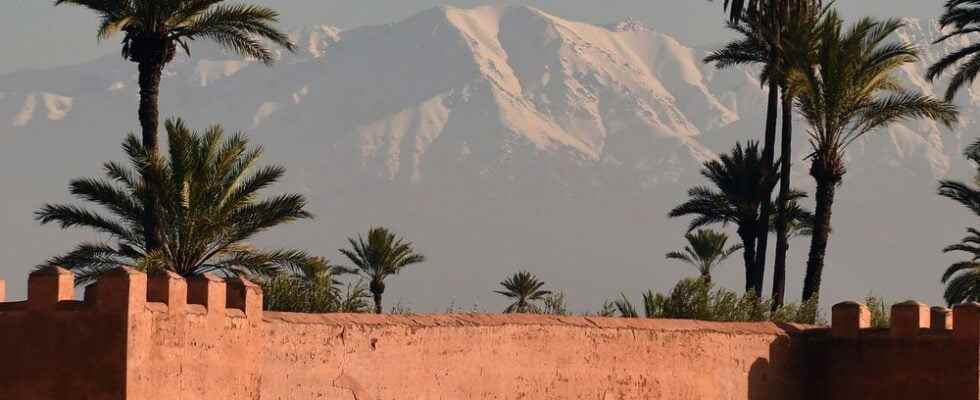With its snake charmers in thick djellabas, its henna tattooists, its Gnaoua musicians and its acrobats, the bustling Jemaa el-Fna square is the living heart of the medina of Marrakech. A meeting point for locals and passing travellers, listed as a UNESCO World Heritage Site, it has helped make the “ocher city” one of the favorite destinations for foreign tourists.
In recent weeks, however, this postcard seemed frozen in the past. Because for two months, Morocco has been locked in place: at the end of November, the kingdom decided to close its airspace due to the appearance of the Omicron variant. An economic disaster for tourism professionals, already weighed down by nearly two years of global pandemic.
A view of Marrakech with the High Atlas mountains in the distance, taken on December 29, 2014. One in ten retirees, or 1.3 million seniors receiving a French pension, chooses to spend their old age abroad, particularly in Morocco .
afp.com/Fadel Senna
Today, Moroccans finally see the end of the tunnel. The country reopened its borders on Monday. “This is excellent news, which we have been waiting for for a long time, enthuses Fouzi Zemrani, tour operator in Marrakech. We will finally be able to breathe and get to work. Now we have to try to save the spring season- summer, because for this winter, it’s already too late.”
“The losses are colossal”
In Morocco, tourism supports nearly 550,000 people, not counting all the small hands of the informal economy: luggage porters, taxi drivers, self-proclaimed guides and other street vendors. This sector contributed 7.1% of GDP in 2019, according to the High Commission for Planning. An underestimated figure since the informal sector accounts for a third of GDP and 80% of jobs in Morocco. “The losses are colossal, deplores Wissal El Gharbaoui, the secretary general of the National Confederation of Tourism. Today, the occupancy rate of tourist accommodation establishments, for those who have remained open, does not exceed 5%. ”
One of the entrances to the famous La Mamounia luxury hotel in Marrakech, southern Morocco, pictured November 2, 2009
afp.com/ABDELHAK SENNA
Devastated, tourism professionals expressed their anger in the street on January 26. Extremely rare in a country where social protest is severely repressed, they gathered, signs in hand, in Essaouira, Marrakech or Tangier. In Rabat, a sit-in was even organized in front of the Ministry of Tourism to demand the reopening of the borders. Long silent on these issues, the government of Aziz Akhannouch ended up hearing their complaints and announced on January 28 the end of this shutdown that had become incomprehensible to thousands of Moroccans.
Among them, some eminent medical personalities, such as Jaâfar Heikel from Casablanca, professor of epidemiology and specialist in infectious diseases. “For three to four weeks, we knew that the epidemiological situation did not justify the maintenance of such restrictive measures, both in terms of severity and incidence,” he summarizes.
At the height of the crisis, Morocco recorded 10,000 daily cases. Thanks to a vigorous vaccination campaign from the end of January 2021, nearly 77% of the population received two doses. Reassuring indicators for a regular clientele not yet ready to shun this sunny destination just a three-hour flight from Paris. “The phone does not stop ringing, we are making reservations for the February holidays and already for those of April”, enthuses Kamil Ennadifi, the owner of the Selman hotel, a palace located on the outskirts of Marrakech. Although dull this winter, the South Gate is beginning to regain color. In the souks, merchants raise the iron curtain and unpack pottery, leather goods and other Berber jewellery. Jemaa el-Fna square is biding its time.
